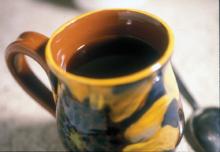People with intracranial aneurysms are more likely to have them rupture after drinking a cup of coffee, said a team of researchers, who suggested that eliminating coffee and making other lifestyle changes might be helpful for people with known intracranial aneurysms.
The researchers also identified vigorous exercise, nose blowing, sexual intercourse, straining to defecate, drinking cola, and being startled or angry as contributing to the immediate risk of rupture – in that order. Among all the triggers, the one with the highest population-attributable risk, or proportion of hemorrhages attributable to the trigger, was 10.6% for coffee consumption, followed by exercise at 7.9%.
Although chronic risk factors for rupture (such as age, female sex, smoking, and alcohol use) have been known to raise the risk of subarachnoid hemorrhage in people with an intracranial aneurysm (IA), only physical exercise had been identified as an immediate trigger. The new study, which was published online May 5 in the journal Stroke, expanded the known triggers for aneurysm rupture, with all eight, its authors noted, associated with short-term increases in blood pressure (Stroke 2011 May 5 [doi:10.1161/ STROKEAHA.110.606558]).
Dr. Monique H.M. Vlak of University Medical Center Utrecht (the Netherlands), the lead author of the study, said in an interview that her team expected to find cigarette smoking to be one of the triggers, based on findings from another study (Stroke 2003;34:1771-6), but they did not.
For their research, Dr. Vlak and colleagues received questionnaires from 250 people who had survived a subarachnoid hemorrhage. Subjects were asked about their exposure to 30 potential triggers in the hour before the hemorrhage, including consuming various caffeinated beverages, smoking, lifting something heavy, becoming angry or surprised, engaging in sexual activity, experiencing temperature change (such as using a sauna), and undertaking vigorous exercise.
Although sexual intercourse and coffee were both associated – independently – with elevated risk in the hour before a rupture, neither masturbation nor tea drinking seemed to matter. However, Dr. Vlak said, few of her study subjects confessed to the former.
"We were also interested to see if Red Bull was a trigger," Dr. Vlak said, referring to the popular energy drink that contains a large amount of caffeine. IA rupture, she noted, affects relatively young people, compared with other cardiovascular events, and the mean age of subjects in this study was 54 years. However, Dr. Vlak said, the number of study subjects who had consumed the drink in the trigger period was too small to matter.
The questionnaire covered the use of the drugs cocaine, marijuana, and sildenafil (Viagra) within 4 hours of the rupture, and any illness or alcohol use within the previous 24 hours. Dr. Vlak said that although cocaine remains a suspected trigger, too few subjects had used it to reach any conclusion.
Subjects were also asked to describe their exposure to all of the potential triggers in the previous year, along with their usual frequency of exposure. The design of the study examined the effect of transient exposure to the potential trigger factors on risk by comparing exposure in the period immediately before the event with the patient’s usual frequency of exposure.
In terms of relative risk, coffee consumption (RR, 1.7; 95% confidence interval, 1.2-2.4), cola consumption (RR, 3.4; 95% CI, 1.5-7.9), anger (RR, 6.3; 95% CI, 1.6-25), becoming startled (RR, 23.3; 95% CI, 4.2-128), straining for defecation (RR, 7.3; 95% CI, 2.9-19), sexual intercourse (RR, 11.2; 95% CI, 5.3-24), nose blowing (RR, 2.3; 95% CI, 1.3-4.5), and vigorous physical exercise (RR, 2.4; 95% CI, 1.2-4.2) were all identified as immediate triggers in the hour before a hemorrhage.
The largest contributors to population-attributable risk were coffee consumption and exercise, followed by nose blowing contributing 5.4%, sexual intercourse contributing 4.3%, straining to defecate contributing 3.6%, cola consumption contributing 3.5%, being startled contributing 2.7%, and being angry contributing 1.3%.
As several of these triggers can be avoided, Dr. Vlak and colleagues wrote in their analysis that "further studies should assess whether reduction of exposure to these factors or measures preventing sudden increase in blood pressure decrease the risk of rupture in patients known to have an intracranial aneurysm."
The authors noted as limitations of their study the relatively long period between the subarachnoid hemorrhage event and subjects’ completion of the questionnaire (about 2 weeks for most subjects), leading to a potential for recall bias.


